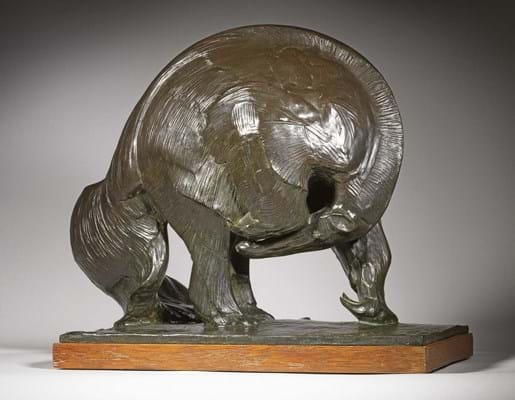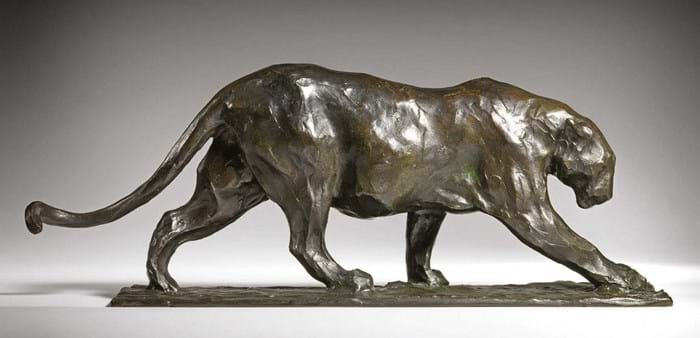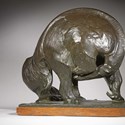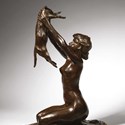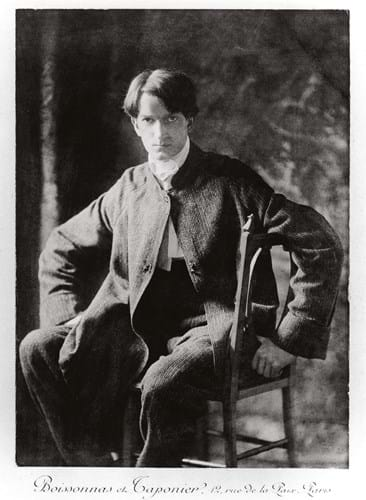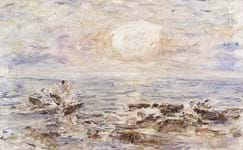The celebrated sculptor spent a short career studying his animal subjects at zoos in Paris and Antwerp, making close studies of individual creatures to inform his work. His output varied from Impressionistic to a more heavily structured style, comprising around 300 sculptures.
In the case of the anteater, completed in 1909, the creature is shown bending to lick its paw. It is a characteristic gesture but also accentuates its natural, circular geometry.
“A lot of our clients are driven by subject matter at the beginning,” says Sladmore’s Edward Horswell, who has specialised in the artist for 50 years.
“Big cats and elephants are popular, but then you’ll get an exceptional example like the anteater which is so unique and modernist that it might appeal to someone who’s interested in the artwork of these pieces.”
Another version of the anteater offered at auction demonstrated its popularity, making a hammer price of €1.2m (£1m) at Drouot in Paris in 2016. This was then the highest price a Bugatti sculpture had ever made at auction in France.
Life and work
The latest anteater now joins 15 other bronzes in a celebration of the artist’s life and work at the St James’s gallery in a show which opened last week, where offerings are priced from £55,000 to more than £1m.
It can be difficult to get a sufficient number of Bugatti works together to stage a show, Horswell adds, so there needs to be a real reason for the occasion. In this case, it is the London publication of The Animal Gazer by Italian author Edgardo Franzosini.
Originally released in Italian in 2015, the book is a novelised biography of the artist’s life. Born in Milan, Rembrandt (named by his painter uncle) was the younger brother of Ettore Bugatti (1881-1947), the auto pioneer.
A lot of our clients are driven by subject matter… but the anteater is so unique and modernist it might appeal to someone who’s interested in the artwork
Their father was a furniture and jewellery designer and Rembrandt started early on to work with foundry and gallery owner Adrian Hébrard, who went on to represent him. In his early 20s he moved to Antwerp for easier access to the city’s Royal Zoological Gardens, the largest zoo in Europe, where he could observe – and often interact with – his subjects.
His work was shown at the Venice Biennale when he was aged just 19, he was awarded the French Légion d’Honneur for art at 27 and was hailed by poet-critic Guillaume Apollinaire.
Personal distress
Franzosini’s novel covers Bugatti’s experience in Paris at the end of the Belle Époque and in the First World War, when he was a stretcher-bearer in an Antwerp hospital. It also chronicles the decision of zoo authorities to put down the animals at the Antwerp zoo during the war as it became increasingly difficult to feed them. Bugatti’s distress at this and the atrocities of war is thought to have contributed to his decision to commit suicide at the age of 31.
UK independent publisher Head of Zeus released the new version of the book in April, following last year’s English language edition that came out in New York. For that event, Sladmore gathered the sculptures pictured in the US edition and offered them in a show at New York’s Taylor Graham gallery.
For the current staging a wider assortment of sculptures is on offer, representing Bugatti’s whole brief career. It is enhanced by a collection of photos, drawing and self-portraits and other memorabilia on loan from the family and the Sladmore archive, contributing to what Horswell dubs “a real Bugatti feast”.
Included are some artworks by other family members, including those by the sculptor’s niece, Lydia Bugatti, an artist in her own right.


